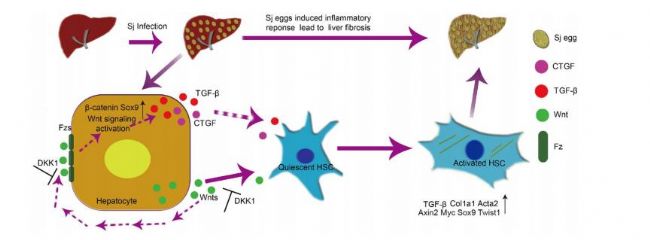Schistosomiasis is a helminth-infectious disease, and it is estimated that more than 200 million people in more than 74 countries are threatened by the disease. Among them, liver fibrosis is the most serious physiological phenomenon caused by Schistosoma japonicum infection.
Recently, researchers from Tongji Medical College of Huazhong University of Science and Technology published an article entitled "Enhanced Wnt Signalling in Hepatocytes is Associated with Schistosoma japonicum Infection and Contributes to Liver Fibrosis", pointing out the previously unknown hepatocyte profibrosis: in hepatocytes Wnt signaling promotes liver fibrosis caused by Schistosoma japonicum infection by inducing expression of TGF-β and CTGF.
The research results were published in the journal Scientific Journal. The first author of the article was Dr. Wang Qi from Tongji Medical College, Huazhong University of Science and Technology. The overexpression of lentivirus used in the study came from Saiye Biotechnology.

Hepatic fibrosis is the most serious physiological phenomenon caused by Schistosoma japonicum infection, which occurs when schistosomiasis is deposited in the liver of the host. The release of soluble antigen (SEA) from schistosomiasis eggs causes changes in the liver microenvironment, triggering immune responses and inflammatory responses. This process stimulates the transformation of heterogeneous cells of hepatic stellate cells (HSCs) into activated myofibroblasts, collagen and extracellular matrix (ECM), which form granulomas and liver fibrosis around the eggs of the schistosomiasis. HSC is a major trigger for collagen deposition in the liver and plays an important role in ECM remodeling of schistosomiasis. The induction of Th2 response by interleukin 4 (IL-4) and interleukin 13 (IL-13)-mediated egg is the key to activation of HSC, induction of schistosome induction, and fibrosis-stimulated collagen production. Transformed growth factor beta (TGF-beta) produced by activated HSC or adjacent hepatocytes is a central hematopoietic vector associated with its downstream effector connective tissue growth factor (CTGF). These well-known pro-inflammatory factors can sequentially cause different intracellular pathways, such as mitogen-activated protein kinase (MAPK), TLR4-MyD88-NF-kB, Hippo or Wnt signaling pathways, which contribute to HSC lateral regulation.
Wnt signaling is an evolutionarily conserved, highly complex pathway. The β-catenin protein is a central participant in the Wnt pathway and plays an important role in the development, regeneration and metabolism of the liver and in maintaining the normal function of the adult liver. It has recently been reported that Wnt signaling is associated with liver fibrosis: studies have shown several Wnt ligands (Wnt3a, Wnt4, Wnt5a and Wnt10b) and Wnt receptors (frizzled1 (Fz1) and frizzled2 (Fz2) in activated stellate liver There is an increase in cells, and higher levels of nuclear β-catenin and T cell factor (TCF) DNA-binding proteins can be observed in activated HSCs. Wnt signaling may be an emerging key to hepatic stellate cell activation and liver fibrosis path.
The researchers used BALB/c mice infected with Schistosoma japonicum to study the expression of Wnt-related molecules, transforming growth factor TGF-β and connective tissue growth factor (CTGF) in hepatocytes, and evaluated Wnt signaling in hepatocyte HSC activation and schistosomiasis. The effect of liver fibrosis. After the introduction of the exogenous Wnt3a gene, liver fibrosis was aggravated, but when the Wnt signal was inhibited using the DKK1 gene, liver fibrosis was attenuated as the expression of TGF-β and CTGF was decreased in hepatocytes. In addition, hepatocytes isolated from infected mice promoted the activation of primary HSCs in vitro; however, they were not observed in co-cultured DKKl-treated hepatocytes infected with Schistosoma japonicum.
The results of this study suggest that the triggering effect of hepatocyte fibrosis caused by schistosomiasis depends on Wnt signaling, and in the future, Wnt signaling may serve as a potential therapeutic target for improving liver fibrosis caused by schistosomiasis.
HbA1c reflects the average blood sugar control for approximately 3 months. The HbA1c Test serves as an important tool in the diabetes management, allowing healthcare providers to monitor long-term glucose control, evaluate treatment effectiveness, and make informed decisions regarding the individual's diabetes care plan.
BioHermes proudly stands as one of the leading manufacturers dedicated to the field of diabetes diagnostics, encompassing both portable handheld testers and sophisticated benchtop analyzers. Our range caters to various testing environments, including both point-of-care (POCT) and non-POCT settings. With utmost precision and efficiency, our analyzers employ cutting-edge boranate affinity chromatography and high-performance liquid chromatography (HPLC) methodologies.
HbA1c Test, HbA1c Assay, HbA1c Analyzer, Handheld HbA1c
Wuxi BioHermes Bio & Medical Technology Co., Ltd. , https://www.biohermesglobal.com
